
A "vertical bull spread" is a portfolio of options. For example, a portfolio of a "long" position in a call option with an exercise price of $1 combined with a "short" position in a call option with an exercise price of $2 will give a fixed gain when the price of the underlying asset is above $2 and a fixed loss when the price of the underlying asset is below $1. Let C_L be the price of the long position call and let C_S be the price of the short position call. Then the price V of the vertical bull spread is V = C_L - C_S. Assume that the prices C_L and C_S of the call options satisfy the Black-Scholes PDE. Substitute V into the Black-Scholes PDE and decide whether or not the price of a vertical bull spread satisfies the Black-Scholes PDE. (b) Consider a vertical bull spread consisting of a long position in a call with an exercise price of $1 and a short position in a call with an exercise price of $2. Both options mature at the same time and use the same underlying asset. Compute the values (not the pay offs) of the two call options at maturity for asset prices of $0.60, $0.80, $1.00, $1.50, $2.00, $2.20, and $2.40. (See the chart for "Call value" in section 3.3.0 of the notes. The value of the short position call will be either negative or zero.) Compute the maturity value of the vertical bull spread by adding the values of the long and short calls, and plot the maturity value of the vertical bull spread. (c) A "butterfly spread" can be constructed by combining a long position in a call option with a low exercise price, a long position in a call option with a high exercise price, and a short position in two call options with an average exercise price. The price of the butterfly in terms of the prices of the three call options is B = C_low + C_high - 2 C_avg. Assume that each of the prices C_low, C_high and C_avg, satisfies the Black-Scholes PDE. Does the price of the butterfly satisfy the Black-Scholes PDE? Explain. (d) [Bonus] For the butterfly spread, suppose the exercise prices of the three call options are $1, $2, and $3, and all have the same maturity. For some prices between $.50 and $3.50, compute the maturity values of the long calls (with $1 and $3 exercise prices) and of the short call (twice the value of a short call with $2 exercise price) and of the butterfly spread, and plot the result. (e) Generalise the results of parts (a) and (c) to the price of a general portfolio of options. A "vertical bull spread" is a portfolio of options. For example, a portfolio of a "long" position in a call option with an exercise price of $1 combined with a "short" position in a call option with an exercise price of $2 will give a fixed gain when the price of the underlying asset is above $2 and a fixed loss when the price of the underlying asset is below $1. Let C_L be the price of the long position call and let C_S be the price of the short position call. Then the price V of the vertical bull spread is V = C_L - C_S. Assume that the prices C_L and C_S of the call options satisfy the Black-Scholes PDE. Substitute V into the Black-Scholes PDE and decide whether or not the price of a vertical bull spread satisfies the Black-Scholes PDE. (b) Consider a vertical bull spread consisting of a long position in a call with an exercise price of $1 and a short position in a call with an exercise price of $2. Both options mature at the same time and use the same underlying asset. Compute the values (not the pay offs) of the two call options at maturity for asset prices of $0.60, $0.80, $1.00, $1.50, $2.00, $2.20, and $2.40. (See the chart for "Call value" in section 3.3.0 of the notes. The value of the short position call will be either negative or zero.) Compute the maturity value of the vertical bull spread by adding the values of the long and short calls, and plot the maturity value of the vertical bull spread. (c) A "butterfly spread" can be constructed by combining a long position in a call option with a low exercise price, a long position in a call option with a high exercise price, and a short position in two call options with an average exercise price. The price of the butterfly in terms of the prices of the three call options is B = C_low + C_high - 2 C_avg. Assume that each of the prices C_low, C_high and C_avg, satisfies the Black-Scholes PDE. Does the price of the butterfly satisfy the Black-Scholes PDE? Explain. (d) [Bonus] For the butterfly spread, suppose the exercise prices of the three call options are $1, $2, and $3, and all have the same maturity. For some prices between $.50 and $3.50, compute the maturity values of the long calls (with $1 and $3 exercise prices) and of the short call (twice the value of a short call with $2 exercise price) and of the butterfly spread, and plot the result. (e) Generalise the results of parts (a) and (c) to the price of a general portfolio of options







